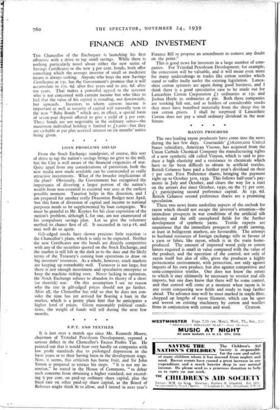RAYON PROGRESS
The two leading rayon producers have come into the news during the last few days. Courtaulds' £16,000,000 Unit:td States subsidiary, American Viscose, has acquired from the Union Carbide Chemical Company' the manufacturing rights of a new synthetic silk called Vinyon, which is said to pro- duce a high elasticity and a resistance to chemicals which have so far been difficult to obtain in artificial textiles. British Celanese have paid a further year's dividend on their 7 per cent. First Preference shares, bringing the payment right up to October 31st, 1939. This follows half-year's pay- ments in July and October, and clears the way for a start on the arrears due since October, 193o, on the 71 per cent. £r participating second preference capital. At 13s. 6d. British Celanese second preference shares are a promising speculation. These two news items underline aspects of the outlook for rayon which should not escape the investor's attention—the immediate prospects in war conditions of the artificial silk industry and the still unexplored fields for the further development of synthetic yarns. Textile experts are unanimous that the immediate prospects of profit earning, at least in belligerent markets, are favourable. The attempt to husband resources of foreign exchange tells in favour of a yarn or fabric like rayon, which is in the main home- produced. The amount of imported wood pulp or cotton linters required is small in value compared with the value of the product, and the operation of the control, not only of rayon itself but also of silks, gives the producer a highly protectionist environment, with protection, not only against imports of his own product, but also against competitive and semi-competitive textiles. One does not know the extent to which it may ultimately be necessary to restrict real silk imports, but one does know that there will be some control, and that control will come at a moment when rayon is in any event conquering new fields and ready to leap farther ahead. The advance may well be most marked in staple fibre, chopped up lengths of rayon filament, which can be spun and woven on existing machinery by cotton and woollen firms in conjunction with cotton and wool. CUSTOS.




































 Previous page
Previous page